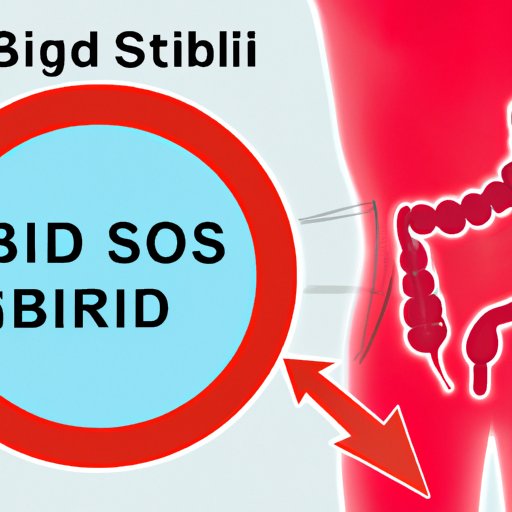
I. Introduction
Small Intestinal Bacterial Overgrowth, or SIBO, is a medical condition where there are abnormally high levels of bacteria in the small intestine. This can result in a multitude of digestive symptoms that can severely impact one’s quality of life. It’s important to understand the symptoms of SIBO, how to get a proper diagnosis, and what treatment options are available.
II. Understanding SIBO Symptoms: A Comprehensive Guide
SIBO is characterized by an overgrowth of bacteria in the small intestine. The bacteria responsible for SIBO is usually found in the large intestine but has migrated to the small intestine where it doesn’t belong. The bacteria ferment food and lead to the production of gas. This gas causes an array of negative symptoms.
The most common symptoms of SIBO include bloating, gas, abdominal pain, diarrhea or constipation, and fatigue. In some cases, SIBO can also lead to weight loss, malabsorption of nutrients, and vitamin deficiencies. The symptoms of SIBO can resemble other gastrointestinal disorders such as Irritable Bowel Syndrome (IBS), which is why it’s essential to seek appropriate medical care to ensure you receive an accurate diagnosis.
III. Are You Experiencing SIBO Symptoms? Here’s What You Need to Know
Recognizing the symptoms of SIBO can be challenging since symptoms vary from one person to another. However, there are common signs to look out for. These include abdominal bloating and distention, gas, diarrhea, constipation, and abdominal pain. The symptoms of SIBO can significantly impact daily life, including work and social activities. Therefore, it’s essential to seek medical help if symptoms persist.
A medical professional will first conduct a thorough medical history and physical exam, possibly followed by breath tests, endoscopies, or blood tests if necessary. The breath test is currently the gold standard for diagnosing SIBO. The test involves ingesting a test sugar, lactulose or glucose, then breathing into a kit at specific time intervals. The test measures the amount of hydrogen and methane gas in the breath to determine the presence of SIBO.
IV. Breaking Down SIBO Symptoms and How to Get a Proper Diagnosis
SIBO symptoms vary significantly between individuals, making it difficult to diagnose. Common SIBO symptoms include abdominal bloating, gas, diarrhea or constipation, abdominal pain or cramps, nausea, and fatigue. These symptoms can make day-to-day life challenging, leading to missed workdays and a decreased quality of life.
A medical professional will conduct various tests to determine a confirmed SIBO diagnosis. These tests include breath tests, endoscopies, and stool samples. Breath tests are the standard diagnostic tool used to measure hydrogen and methane gases in the breath, while endoscopies assess the condition of the gastrointestinal tract. Stool samples may also be used to test for SIBO.
V. Suffering from Digestive Issues? It May be SIBO. Learn the Symptoms and Treatment Options
The treatment of SIBO is paramount in managing symptoms. Antibiotics are the first line of treatment and are very effective. However, diet, lifestyle, and probiotics may also prove useful. Lifestyle factors to consider include reducing stress levels, getting enough sleep, and increasing physical activity. Diet changes involve reducing high fermentable carbs such as grains and sugar. A registered dietitian or nutritionist can also be a considerable asset in the management of SIBO. They’ll help create an appropriate dietary plan that will suit you as an individual.
Probiotics can help restore a healthy balance of gut bacteria after antibiotic therapy. They might also help reduce symptoms of SIBO, although the evidence for their effectiveness is less convincing. However, taking an effective and appropriate probiotic can help reduce symptoms and expedite the recovery process.
VI. The Telltale Signs of SIBO: How to Recognize Symptoms and Seek Treatment
SIBO can manifest in several symptoms that significantly impact day-to-day life. These include abdominal bloating, constipation, diarrhea, abdominal pain, and nausea, among others. Anyone experiencing such symptoms should seek medical attention as soon as possible. Early diagnosis and treatment of SIBO are critical in preventing further complications and alleviating symptoms.
A medical history and physical examination are often used to determine the likelihood of SIBO. Various diagnostic tools, including breath tests and endoscopies, can then be used to confirm the diagnosis. Treatment options for SIBO include antibiotics, diet changes, and probiotics.
VII. The Invisible Culprit Behind Your Digestive Woes: A Look at SIBO Symptoms and Causes
Several factors can trigger the overgrowth of bacteria in the small intestine, resulting in SIBO. These include lifestyle factors such as poor diet or the use of certain medications that disrupt gut bacteria.
Underlying medical conditions such as Crohn’s disease, celiac disease, and diabetes can also trigger the overgrowth of bacteria. Prior GI surgery, radiation treatment, or motility issues that slow down intestinal movement can similarly increase SIBO’s likelihood.
The importance of maintaining a healthy gut cannot be overstated. SIBO is a sign that something is amiss with gut health and can have a significant impact on overall well-being. By understanding the signs and symptoms of SIBO, seeking proper diagnosis and treatment, and taking a proactive approach towards gut health, those impacted by SIBO can regain control of their lives.




